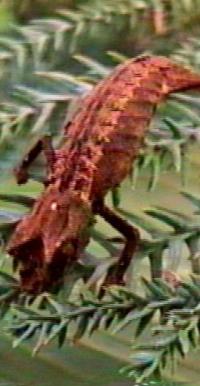Salamander - Eastern Long Toed
Central Long Toed Salamander Scientific Name: Abystoma macrodactylum columbianum
Mon, 28th April, 2025 - 8:20 am GMT
Sponsor Ads:

Alternative Name
Central Long Toed Salamander Scientific Name: Abystoma macrodactylum columbianumBasic Info
Eastern Long Toed Salamanders have a jagged edged stripe along their backs that is essentially made up of overlapping tan or yellow splotches. This stripe runs from the head to the tail tip. Splotches may also be evident on the head. The background color of this salamander is dark brown or black. Some Eastern Long Toed Salamanders may have silver or white spots on the sides of their bodies. The belly is a sooty or dark brown color. There are usually 12 or 13 costal grooves on the Eastern Long Toed Salamander. True to its name, this salamander has long toes. Its body is slender, and it can grow to between 4 and 6.5 inches (10 and 17 centimeters).
Health
Breeding Usually, Eastern Long Toed Salamanders breed between January and June. Generally, breeding season is determined more by latitude than by temperature. They lay their eggs on submerged vegetation, and they may lay the eggs in clusters or singles. The single eggs are generally found closer to the surface, while clusters may be in the deepest area of the water in a protected area such as the underside of a log. Usually, the eggs hatch in about three weeks, and the Eastern Long Toed Salamanders will generally remain in the larval state until the summer after they were hatched.Habitat
Usually, Eastern Long Toed Salamanders are found in a variety of habitats, from scrublands to mountain forests. Usually, they live between sea level and an elevation of about 9,000 feet (2,743 meters).Behavior
Once called the Central Long Toed Salamander, the Eastern Long Toed Salamander is found in a variety of habitats. With its interesting coloration and long toes, the Eastern Long Toed Salamander is a very interesting creature. Eastern Long Toed Salamanders are nocturnal. During the day, they can sometimes be found under rocks, logs, or leaves. Some hide underground during the day, although almost all are found near water. At night, they hunt for insects or worms. Usually, Eastern Long Toed Salamanders remain close to the pool they were hatched in, though some may be found further away. Eastern Long Toed Salamanders are often rare, and they may be easiest to see when they are migrating toward breeding ponds.Origin
North AmericaHistory
The Eastern Long Toed Salamander usually lives between California and Alaska, and ranges east through the United States through Montana. In some areas of Canada, they may be considered at risk because their populations are quite patchy, and in some areas they may be rare.Common Foods
feeds primarily on insects, earthworms, small rodents, small animals.Sponsor Ads:
The ship of state is the only ship that leaks at the top. -- Unknown
Salamander - Eastern Long Toed
Coded by: BGID® | ALL RIGHTS RESERVED Copyright © 2000-2025
Disclaimer | Privacy | Report Errors / Contact | Credits








 Why haven't we as a collective earth met with aliens yet?
Why haven't we as a collective earth met with aliens yet?  The Best Text Adventure You Will Ever Play! The official site:
The Best Text Adventure You Will Ever Play! The official site:  Homosexual behavior stems from the mind or genetics?
Homosexual behavior stems from the mind or genetics?  World EcoSystem - Biodiversity Changes - Who is on board and who isn
World EcoSystem - Biodiversity Changes - Who is on board and who isn  Mouthwash - Mouthrinse - Mouth Sores - Healing Infections - Gingivitis
Mouthwash - Mouthrinse - Mouth Sores - Healing Infections - Gingivitis  Treatment for Depression
Treatment for Depression  Ultra radical and violent Islamist group that even rivals Al Qaeda
Ultra radical and violent Islamist group that even rivals Al Qaeda  An idea to have teachers who want to carry guns to school undergo some level of police training will be left up to local school districts and police departments.
An idea to have teachers who want to carry guns to school undergo some level of police training will be left up to local school districts and police departments.